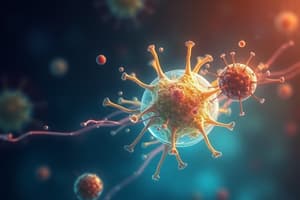Podcast
Questions and Answers
Which of the following characteristics is NOT commonly associated with eukaryotes?
Which of the following characteristics is NOT commonly associated with eukaryotes?
- Larger cell size
- Presence of a nucleus
- Presence of membrane-bound organelles
- Absence of cytoskeleton (correct)
What distinct kind of reproduction is typically associated with eukaryotic organisms?
What distinct kind of reproduction is typically associated with eukaryotic organisms?
- Asexual reproduction only
- Sexual reproduction (correct)
- Binary fission
- Cloning
Which of the following structures is characteristic of eukaryotic cells?
Which of the following structures is characteristic of eukaryotic cells?
- Larger ribosomes (80S) (correct)
- Small ribosomes (70S)
- Nucleoid region
- Capsule
The endosymbiotic theory primarily explains the origin of which eukaryotic structures?
The endosymbiotic theory primarily explains the origin of which eukaryotic structures?
Which statement regarding protists and multicellularity is accurate?
Which statement regarding protists and multicellularity is accurate?
Flashcards
Eukaryote Characteristics
Eukaryote Characteristics
Eukaryotes have a true nucleus and membrane-bound organelles, larger cells (over 10µm diameter), and linear DNA.
Eukaryote vs. Prokaryote
Eukaryote vs. Prokaryote
Eukaryotes have a nucleus and membrane-bound organelles (like mitochondria, lysosomes), while prokaryotes lack these features.
Endosymbiotic Theory
Endosymbiotic Theory
A theory proposing that mitochondria and chloroplasts evolved from prokaryotic cells living inside larger cells.
Multicellular Organisms
Multicellular Organisms
Signup and view all the flashcards
Cytoskeleton in Eukaryotes
Cytoskeleton in Eukaryotes
Signup and view all the flashcards
Study Notes
Eukaryotes Introduction
- Eukaryotes have a true nucleus and membrane-bound organelles
- Key characteristics of eukaryotes include:
- Nucleus
- Cytoskeleton
- Membrane-bound organelles (ER, Golgi, lysosomes, vacuoles, peroxisomes, mitochondria, chloroplasts)
- Asexual reproduction (various methods)
- Cell walls (in some)
- Capsules (in some)
- Binary fission (in some)
- Cilia or flagella (in some)
- Linear DNA associated with proteins
- Larger ribosomes (80S)
- Larger cell size (>10 μm diameter)
- Mitosis and meiosis
- Multicellular forms (in some)
Eukaryote Objectives
- Identify common characteristics of eukaryotes.
- Explain the endosymbiotic theory.
- Describe how multicellular forms may have evolved from protists.
Prokaryote/Eukaryote Comparison
- Prokaryotes lack a nucleus and membrane-bound organelles.
- Eukaryotes have a true nucleus and membrane-bound organelles.
- Both can have cell walls, capsules, binary fission, and be unicellular.
Eukaryote Evolution
- Eukaryotes are thought to have evolved from prokaryotes
- The endosymbiotic theory proposes that mitochondria and chloroplasts originated from free-living prokaryotes that were engulfed by a larger cell
- Evidence for endosymbiosis includes:
- Mitochondria and chloroplasts have their own DNA
- Mitochondria and chloroplasts have their own ribosomes
- Mitochondria and chloroplasts divide by binary fission
Kingdom Protista
- Protists are a diverse group of eukaryotic organisms.
- Protists can be plant-like, animal-like, or fungus-like.
- Plant-like protists are photosynthetic (e.g., algae).
- Animal-like protists are heterotrophic (e.g., protozoa).
- Fungus-like protists are decomposers (e.g., slime molds).
- Protists arose from prokaryotes, and their descendants gave rise to all plants, fungi, and animals as well as modern protists.
- Classification is difficult due to the wide diversity of protists.
Classification of Protists
- Protists are classified by their mode of nutrition (plant-like, animal-like, or fungus-like).
- This system is artificial (non-phylogenetic), and the best approach is the traditional system of single kingdom Protista
Plastid Evolution
- Plastids (e.g., chloroplasts) are produced through secondary endosymbiosis.
- Mitochondria arose first then plastids.
- Organisms with plastids (chloroplasts) evolved from photosynthetic prokaryotes engulfed by heterotrophic eukaryotes.
Studying That Suits You
Use AI to generate personalized quizzes and flashcards to suit your learning preferences.




